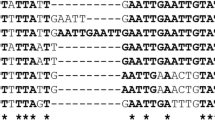Abstract
DNA markers have the potential to be a powerful tool for the molecular study and breeding of agronomic traits of temperate forage grasses, but some of these grasses have only limited sequence information available. We aimed to design highly transferable primer sets by using the abundant sequence information available for related crop species such as wheat and rice. The degree of similarity between the primer sequences of the wheat PCR-based landmark unique gene (PLUG) primer set and the corresponding sequences of rice orthologs was designated as the “universality index” (UI). We classified 359 PLUG primer pairs based on their UI values and found that primer pairs with high UI values showed higher successful amplification rates in Festuca and Lolium species than those with low UI values. Based on these results, we designed new primer sets, designated Conserved Three-prime-End Region (COTER) primers, with complete similarity to rice orthologs for eight bases at the 3′ end of each primer. COTER primer sets developed from both tall fescue and wheat showed high transferability in six temperate grasses (mean amplification rates of 95% for tall fescue primers; 79% for wheat primers). This strategy and primer information could also be useful for developing DNA markers for other grass species with little genome information available.


Similar content being viewed by others
References
Ayyadevara S, Thaden JJ, Reis RJS (2000) Discrimination of primer 3′-nucleotide mismatch by Taq DNA polymerase during polymerase chain reaction. Anal Biochem 284:11–18
Collins M, Fritz JO (2003) Forage quality. In: Barnes RF, Nelson CJ, Collins M, Moore KJ (eds) Forages: an introduction to grassland agriculture, vol 1. Iowa State University Press, Ames, pp 363–390
Feltus FA, Singh HP, Lohithaswa HC, Schulze SR, Silva TD, Paterson AH (2006) A comparative genomics strategy for targeted discovery of single-nucleotide polymorphisms and conserved-noncoding sequences in orphan crops. Plant Physiol 140:1183–1191
Fredslund J, Madsen LH, Hougaard BK, Sandal N, Stougaard J, Bertioli D, Schauser L (2006) GeMprospector—online design of cross-species genetic marker candidates in legumes and grasses. Nucleic Acids Res 34:W670–W675
International Brachypodium Initiative (2010) Genome sequencing and analysis of the model grass Brachypodium distachyon. Nature 463:763–768
Ishikawa G, Yonemaru J, Saito M, Nakamura T (2007) PCR-based landmark unique gene (PLUG) markers effectively assign homoeologous wheat genes to A, B and D genomes. BMC Genomics 8:135
Ishikawa G, Nakamura T, Ashida T, Saito M, Nasuda S, Endo TR, Wu J, Matsumoto T (2009) Localization of anchor loci representing five hundred annotated rice genes to wheat chromosomes using PLUG markers. Theor Appl Genet 118:499–514
Jayashree B, Jagadeesh VT, Hoisington D (2008) CISprimerTOOL: software to implement a comparative genomics strategy for the development of conserved intron scanning (CIS) markers. Mol Ecol Resour 8:575–577
Kellogg EA (1998) Relationships of cereal crops and other grasses. Proc Natl Acad Sci USA 95:2005–2010
Lohithaswa HC, Feltus FA, Singh HP, Bacon CD, Bailey CD, Paterson AH (2007) Leveraging the rice genome sequence for monocot comparative and translational genomics. Theor Appl Genet 115:237–243
Lyons LA, Laughlin TF, Copeland NG, Jenkins NA, Womack JE, Obrien SJ (1997) Comparative anchor tagged sequences (CATS) for integrative mapping of mammalian genomes. Nat Genet 15:47–56
Murray MG, Thompson WF (1980) Rapid isolation of high molecular weight plant DNA. Nucleic Acids Res 8:4321–4325
Petruska J, Goodman MF, Boosalis MS, Sowers LC, Cheong C, Tinoco I Jr (1988) Comparison between DNA melting thermodynamics and DNA-polymerase fidelity. Proc Natl Acad Sci USA 85:6252–6256
R Development Core Team (2005) R: a language and environment for statistical computing. R Foundation for Statistical Computing, Vienna, ISBN 3-900051-07-0. URL http://www.R-project.org
Rozen S, Skaletsky H (2000) Primer3 on the WWW for general users and for biologist programmers. In: Misener S, Krawetz SA (eds) Methods mol biol, vol 132. Humana Press Inc, Totowa, pp 365–386
Saal B, Wricke G (1999) Development of simple sequence repeat markers in rye (Secale cereale L.). Genome 42:964–972
Sommer R, Tautz D (1989) Minimal homology requirements for PCR primers. Nucleic Acids Res 17:6749
Tamura K, Yonemaru J, Hisano H, Kanamori H, King J, King IP, Tase K, Sanada Y, Komatsu T, Yamada T (2009) Development of intron-flanking EST markers for the Lolium/Festuca complex using rice genomic information. Theor Appl Genet 118:1549–1560
Thompson JD, Higgins DG, Gibson TJ (1994) CLUSTAL W: improving the sensitivity of progressive multiple sequence alignment through sequence weighting, position-specific gap penalties and weight matrix choice. Nucleic Acids Res 22:4673–4680
Wang X, Zhao X, Zhu J, Wu W (2005) Genome-wide investigation of intron length polymorphisms and their potential as molecular markers in rice (Oryza sativa L.). DNA Res 12:417–427
Wei H, Fu Y, Arora R (2005) Intron-flanking EST-PCR markers: from genetic marker development to gene structure analysis in Rhododendron. Theor Appl Genet 111:1347–1356
Yamada T, Tamura K, Wang X, Aoyagi Y (2009) Transgenesis and genomics in forage crops. In: Jain S, Brar D (eds) Molecular techniques in crop improvement, 2nd edn. Springer, New York, pp 719–743
You FM, Huo NX, Gu YQ, Lazo GR, Dvorak J, Anderson OD (2009) ConservedPrimers 2.0: a high-throughput pipeline for comparative genome referenced intron-flanking PCR primer design and its application in wheat SNP discovery. BMC Bioinform 10:331
Zeid M, Yu JK, Goldowitz I, Denton ME, Costich DE, Jayasuriya CT, Saha M, Elshire R, Benscher D, Breseghello F, Munkvold J, Varshney RK, Belay G, Sorrells ME (2010) Cross-amplification of EST-derived markers among 16 grass species. Field Crops Res 118:28–35
Acknowledgments
We thank Ms. Yukari Ikenobe and Ms. Satomi Shimada for their technical assistance. This work was supported by a grant from the Ministry of Agriculture, Forestry, and Fisheries of Japan (Genomics for Agricultural Innovation, SOR-0006).
Author information
Authors and Affiliations
Corresponding author
Electronic supplementary material
Below is the link to the electronic supplementary material.
Rights and permissions
About this article
Cite this article
Tamura, Ki., Kiyoshi, T. & Yonemaru, Ji. The development of highly transferable intron-spanning markers for temperate forage grasses. Mol Breeding 30, 1–8 (2012). https://doi.org/10.1007/s11032-011-9593-7
Received:
Accepted:
Published:
Issue Date:
DOI: https://doi.org/10.1007/s11032-011-9593-7




